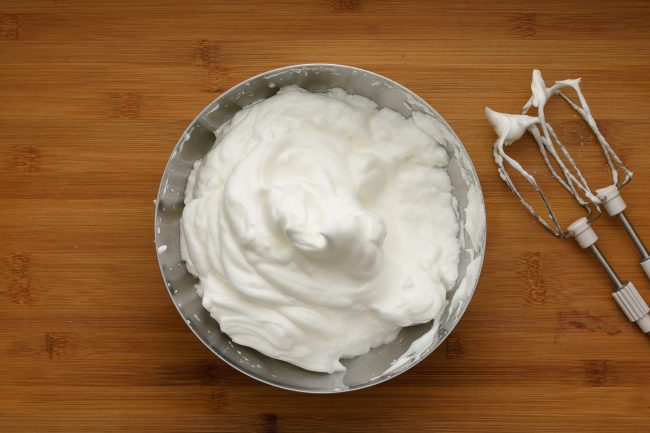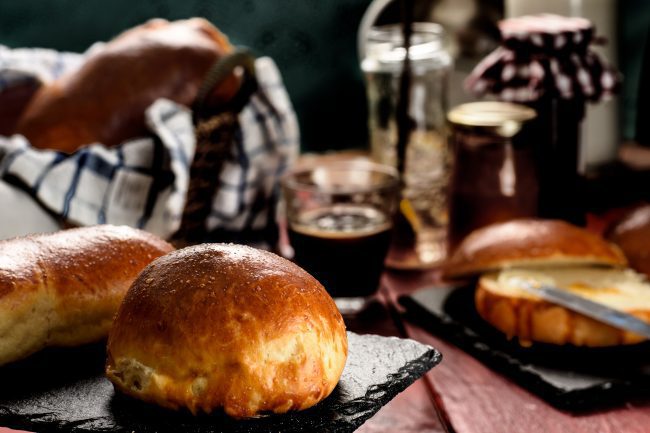Fascinated by how do eggs work to create delight? Check out this article that will shed light on this culinary might!
 Eggs may be considered the most important ingredient in our fridge! They are nutritious, taste great, and their physical properties and components make them indispensable in our kitchen. The foundation on which many cooking techniques and recipes depend is formed by eggs.
Eggs may be considered the most important ingredient in our fridge! They are nutritious, taste great, and their physical properties and components make them indispensable in our kitchen. The foundation on which many cooking techniques and recipes depend is formed by eggs.
Protein Power
Along with water, protein plays a key role in egg yolks and whites. Long chains of amino acids, tightly coiled by weak bonds, constitute protein. When protein is heated or air is beaten into it, its bonds come apart, and the chain is partly unwound. The protein is now denatured, or changed from its natural state.
As the proteins unfold, their hydrophobic (water-hating) and hydrophilic (water-loving) ends are exposed. New bonds are formed, arranging the proteins so that their water-hating ends are in the air and their water-loving ends are in the water. This creates a web of protein molecules that hold the air bubbles in place. If the proteins are overheated or overbeaten, the bonds will tighten, and the moisture will be squeezed out, leaving the eggs dry, firm, and rubbery.
The Role of Eggs in Cooking and Baking
Temperature facts
- 30°F – 140°F / -1°C – 60°C
As it gets hot, its proteins, which resemble coiled-up balls of yarn, slowly start to uncoil. - 140°F / 60°C
Some of these uncoiled proteins—called ovotransferrin—begin to bond with each other, creating a matrix and turning the egg white milky and jelly-like (like the innermost layers of egg white in the three-minute egg above). - At 155°F / 68°C
An opaque solid is formed by the ovotransferrin, though it is still quite soft and moist (see the white of the five-minute egg). - At 180°F / 82°C
The main protein in egg whites—ovalbumin—will cross-link and solidify, giving us a totally firm egg white (see the whites of the seven- and nine-minute eggs). This is very similar to the gunk that seeps out of the surface of overcooked salmon. - At 180°F / 82°C and up
The hotter the egg gets, the tighter these proteins bond, and the firmer, drier, and more rubbery the egg white becomes (see the 11- and 15-minute eggs). Aromas of hydrogen sulfide, or “rotten egg,” begin to develop.
On the other hand, egg yolks follow a different set of stages:
- 145°F / 63°C
Begin to thicken and set up. - 158°F / 70°C
Become totally firm but are still bright orange and shiny. - 170°F / 77°C
Become pale yellow and start to turn crumbly. - 170°F / 77°C and up
Dry out and turn chalky. The sulfur in the whites rapidly reacts with the iron in the yolks, creating ferrous sulfide and tinging the yolks.
Leavening
 A great ability to leaven or puff up foods is found in eggs when air is beaten into them. Especially good at this are egg whites, which create a foam with more stability and volume than whole eggs or yolks when beaten.
A great ability to leaven or puff up foods is found in eggs when air is beaten into them. Especially good at this are egg whites, which create a foam with more stability and volume than whole eggs or yolks when beaten.
When air is incorporated into the protein molecules in egg whites, the proteins are unwound and stretched to form an elastic web that encases the air bubbles. Egg whites can be expanded up to eight times their volume. They provide volume and structure to soufflés, angel food cake, and meringues.
The best foam volume and stability are achieved with room temperature egg whites. Adding an acid (e.g., cream of tartar, vinegar, lemon juice) will help to strengthen and stabilize the foam. The foaming ability of the whites will be diminished by any fat, such as a trace of egg yolk mixed in with the whites, or oil in the bowl, or butter or cream on the mixing utensils.
Whole eggs and yolks can also trap and hold air that expands during heating, leavening cake batters, and sauces such as sabayon.
Emulsification
An emulsion, the blending of two incompatible liquids such as oil and water, is exemplified by Hollandaise sauce and mayonnaise. Since these two liquids don’t mix, an emulsifier is needed to hold the oil molecules in the water without the ingredients separating. The lecithin in egg yolks serves as an excellent emulsifier. With the water-loving end of the lecithin molecule buried in the water molecules and the water-hating end buried in the oil molecules, lecithin forms a thin film around tiny drops of oil, enabling them to remain suspended in a water-based liquid.
Creamy desserts such as crème brûlée also benefit from our ability to emulsify and produce smooth, satiny, homogeneous mixtures.
Thickening
The ability to hold up to four times our weight in moisture makes it a good thickener for sauces, custards, and curds. The proteins in eggs coagulate or set at different temperatures, resulting in thickening. However, it means that eggs must be cooked gently and heated carefully, or we will scramble rather than thicken a sauce or other mixture.
Binding
As binding agents, we can bind ingredients together, giving strength and stability to meatloaves, casseroles, and baked goods.
Coating and Sealing
 We are used to coat foods with crumbs, flour, etc., as we help these ingredients adhere and also create a browned appearance when cooked. Our stickiness allows us to be used to bond two pieces of dough or pastry together (e.g., a decorative pastry garnish on a pie crust) or to provide a sticky surface on which to sprinkle seeds (e.g., poppy seeds on the top of a bun).
We are used to coat foods with crumbs, flour, etc., as we help these ingredients adhere and also create a browned appearance when cooked. Our stickiness allows us to be used to bond two pieces of dough or pastry together (e.g., a decorative pastry garnish on a pie crust) or to provide a sticky surface on which to sprinkle seeds (e.g., poppy seeds on the top of a bun).
Color and Shine
Protein browns when exposed to heat. Brushing pies, biscuits, breads, and buns with an egg wash (beaten eggs alone or combined with water, milk, or cream) before baking gives them a bronzed and glossy sheen. Yolk only egg wash provides a deeper darker brown while the egg white only egg wash provides more shine to the baked goods.
What do egg labels mean?
A variety of different labels can be seen slapped onto our cartons of eggs.
- Cage-Free
Hens are not confined to a cage; however, they may not be running happily around a field. Cage-free can constitute a wide array of chicken environments, from being cramped in a warehouse to wandering around outside. - Free-Range
Hens are allowed to roam outside for at least part of the day. - Natural
The term “natural” is not regulated, so this could mean anything the manufacturer wants it to mean. - Organic
The term “organic,” unlike “natural,” is mandated. Organic hens are fed organic vegetarian diets free from genetically-modified foods or foods produced with pesticides. Antibiotics or vaccines are not administered to the hens, and they are often also cage-free. - Pasteurized
Pasteurized eggs have been heated in their shells to 140°F / 60°C for 3.5 minutes. This kills many of the bacteria, namely Salmonella, making this a good option for those with weakened immune systems.
Side note: The eggs bought at the store are not unhatched baby chickens. 99% of the time, these are eggs that went unfertilized. If they were to have been fertilized, the yolk would have been the nutrient source that the baby bird would have used to grow. Hens will typically lay an egg every 25 hours, fertilized or not.
How to store eggs
 Refrigerated
Refrigerated
Eggs will stay good for about a month when refrigerated. Testing whether our eggs are still good can be done by placing an egg in a full glass of water. If the egg lies flat on the bottom, it is fresh. If it stands up, it’s on its way to going bad. And if our egg floats, it should be tossed.- Room Temperature
It’s okay to store eggs at room temperature depending on the production method. In America, eggs are power washed before selling. This removes the natural coating that protects the eggs from nasty bacteria, so eggs must be kept below 40 degrees F to ward off potential foodborne pathogens. Some countries (like most European countries) choose to leave this layer on, so if we go abroad and panic because the eggs are all sitting out, it’s okay! - Frozen
Freezing tolerates egg whites well, though the yolks do not. Separating the whites from the yolk and placing them in an ice cube tray will allow for freezing.
How to cook eggs
- Hard boiled
The eggs are lowered straight from the fridge into already-boiling water. If in a hurry, then instead of waiting for a pot of water to come to a boil, all we need to do is boil a half-inch of water. Throw our steamer insert in, cover the pot, set the timer, and we’ve got perfectly cooked eggs.
If boiling, the heat should be lowered to the barest simmer. The eggs should be cooked for 11 minutes for hard or 6 minutes for soft. They can be served right away. If we are serving them cold, they can be shocked in ice water immediately which also helps reducing dimples.
The cooler the egg is, the firmer and tighter its structure will be, and the less likely it will be to develop craters when the shell is prying off. We can let them chill in that water for at least 15 minutes or, better yet, in the fridge overnight. Peeling can be done under cool running water. - Scrambled
To make scrambled Eggs, the eggs are whisked up in a bowl. A dash of milk for each egg can be added and continued to be whisked along with salt, pepper and any additional spices, herbs or some cheese. Cooking can be done in a skillet over low heat, constantly stirring and scrambling, until the eggs are cooked and fluffy. - Sunny-Side Up
An egg carefully cracked into a pan and cooked over medium to high heat, for about 3 minutes. - Poached
A pan of water is brought to a slow simmer, and a dash of white vinegar can be added. The egg then cracked into a shallow cup, then gently eased into the water. Cooking is done for 2 to 4 minutes. The egg is then removed and set on a paper towel to dry. Great on Savory Oatmeal!
Egg nutrition facts
Nutrition info for 1 large egg (about 50g)
– Calories: 70
– Carbohydrates: 0g
– Protein: 6g
– Fat: 5g, 185 mg cholesterol
– The Egg White: 3.5g protein, 0.05g fat with additional Magnesium, Potassium, Sodium
– The Egg Yolk: 2.5g protein, 4.5g fat with additional Vitamin A, Vitamin D, Vitamin B12, Calcium, Phosphorus, Choline, Folate
Research is beginning to indicate that our dietary cholesterol may not have as great of an impact on our blood cholesterol as previously thought. Recent studies suggest that egg consumption of 1 egg per day is not related to an increased risk of heart disease in healthy populations. For those with high LDL (Low-Density Lipoprotein) and total cholesterol, however, reduction of dietary cholesterol may be beneficial.
 Refrigerated
Refrigerated